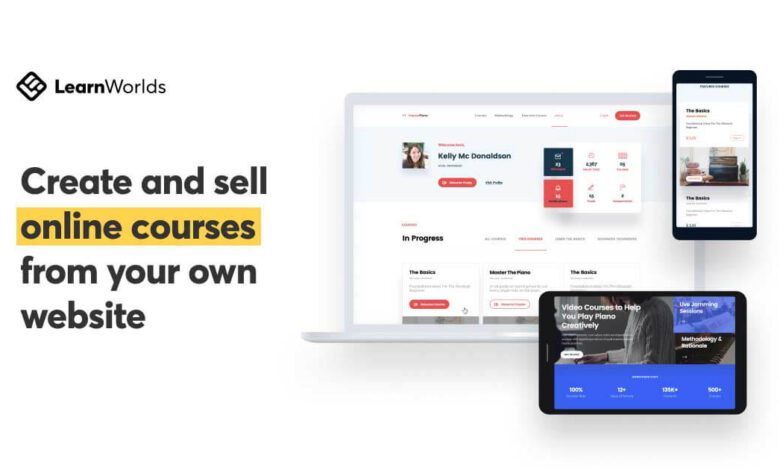How to create a cost-effective training budget for your business

It’s the most wonderful time of the year—budget planning. While it might not be as exciting as launching a new product or celebrating a milestone, preparing your training budget is a critical task that sets the foundation for your business’s success.
A well-planned budget for training and development allows you to prioritize initiatives, allocate resources efficiently, and align training efforts with your business goals. Whether upskilling employees, onboarding new hires, or educating customers, a comprehensive overall training budget that accounts for all educational initiatives will help you stay on track with your finances.
Of course, managing training budgets can feel overwhelming, with so many variables to consider. But with a thoughtful approach, you can take the guesswork out of the process. This guide will walk you through developing a training budget template to help you optimize resources, evaluate costs accurately, track expenses, and maximize ROI.
Let’s dive in.
First things first: why do you need a training budget?
A training budget is more than just a financial exercise—it’s a strategic tool for ensuring your learning initiatives deliver real value to your organization. Whether you’re training employees or educating customers, a smart budget sets the stage for impactful programs without breaking the bank.
Here’s why creating one is essential:
Align training with business goals
Training and business goals go hand in hand, so budgeting is an essential part of your strategy. A structured budget ensures your training programs directly support organizational priorities, such as improving performance, enhancing customer satisfaction, or scaling operations.
Prioritize resources effectively
Training budget allocation is tricky when you have multiple needs. When you identify and calculate training costs in advance, you can allocate resources more effectively to prioritize and support your most critical training needs.
Keep employees and customers engaged
A thoughtful training budget can help you offer training on a regular basis and foster a culture of continuous learning. Regular training, whether for employees or customers, helps participants stay informed, confident, and deeply engaged with your organization.
Demonstrate ROI and accountability
With a clear breakdown of spending and outcomes, you can track key metrics, like productivity gains, customer satisfaction, and retention rates, to prove training ROI. This transparency justifies your investment and strengthens future budget proposals.
Minimize hidden costs and inefficiencies
Proper budget planning reduces surprises too common in learning and development activities, such as trainer fees or additional software expenses. Mapping out expenses ensures you avoid costly mistakes or redundancies in training efforts.
Reduce unnecessary training costs
Having a learning and development budget will help you project expenses more accurately and make necessary adjustments to find more cost-effective training solutions, such as choosing online courses over on-site, to reduce unnecessary expenses.
Support long-term success
A comprehensive budget ensures that your initiatives are sustainable, scalable, and aligned with your overall strategy, helping your organization grow while managing costs effectively. A well-planned training budget can help you provide ongoing training to achieve your company goals and drive your organization forward.
By taking the time to learn how to manage a training budget, you’ll create a roadmap for impactful learning programs that drive measurable results for both your team and your customers.
How to prepare a training budget: a step-by-step guide
Creating a training budget requires a holistic approach that considers all aspects of your training programs, from identifying needs to evaluating impact. Here’s how to calculate training budget costs and manage your budget effectively:
Step 1. Identify your training needs
Start by pinpointing knowledge or skill gaps within your organization or among your customers. Use tools like surveys, performance reviews, and customer feedback to determine priorities.
For example, employees might need upskilling to handle new tools, while customers could benefit from a structured onboarding program or advanced product training. This ensures your budget targets the most impactful areas.
Step 2. Define your objectives
Clearly articulate the purpose of your training initiatives, whether it’s addressing skill gaps, enhancing product adoption, meeting compliance requirements, or driving innovation.
Defining measurable outcomes helps focus your budget on initiatives that align with strategic business goals. Create SMART goals that you can use as benchmarks to measure the effectiveness of your programs.
Step 3. Identify your audience
Segment your learners to tailor training effectively. For employees, consider roles, departments, or seniority levels. For customers, segment by job role, subscription tier, or industry. A targeted approach ensures your budget is spent on the right audiences.
Step 4. Choose delivery methods
Select training methods based on your audience’s preferences and content type. Options include:
eLearning modules for scalable, self-paced learning, delivered via a Learning Management System.
Synchronous online sessions, such as webinars, for better engagement and live demonstrations.
Blended learning that combines digital and live components.
On-site training sessions for hands-on training and practice.
Step 5. Use business budgeting software
Business budgeting software streamlines financial management and allows you to monitor your budget by tracking income and expenses, predicting training costs, and automating core tasks, such as categorizing expenses or allocating resources.
Step 6. Create a template to allocate costs by key categories
Break your budget into these primary components to manage training expenses effectively and ensure you don’t leave anything out.
The following template maps out the most common expenses for employee training:
Expense category
On-site employee training
Online employee training
Content development
Manuals, presentation slides, team activities
Interactive modules, videos, simulations, quizzes
Training platform
N/A
Learning Management System (LMS), webinar tools (e.g., Zoom, Microsoft Teams)
Other tools and equipment
Projectors, whiteboards, group activity tools
Webcams, microphones, screen-sharing tools, video recording software
Training needs assessment tools
Survey, assessment & performance evaluation tools
Survey, assessment & performance evaluation tools
Trainers and consultants
Industry specialists, HR trainers
Industry specialists, HR trainer, moderators for live Q&A
Marketing and promotion
Internal newsletters, chat tools (e.g., Slack)
Internal newsletters, chat tools (e.g., Slack)
Post-training evaluation and analytics
Survey tools
Built-in LMS analytics & survey tools
Venue and facilities
Conference rooms, training centers, rented halls, catering
N/A
Travel fees and accommodation
Trainer/participant transportation, hotel stays
N/A
Expense category
On-site employee training
Online employee training
Content development
Manuals, presentation slides, team activities
Interactive modules, videos, simulations, quizzes
Training platform
N/A
Learning Management System (LMS), webinar tools (e.g., Zoom, Microsoft Teams)
Other tools and equipment
Projectors, whiteboards, group activity tools
Webcams, microphones, screen-sharing tools, video recording software
Training needs assessment tools
Survey, assessment & performance evaluation tools
Survey, assessment & performance evaluation tools
Trainers and consultants
Industry specialists, HR trainers
Industry specialists, HR trainer, moderators for live Q&A
Marketing and promotion
Internal newsletters, chat tools (e.g., Slack)
Internal newsletters, chat tools (e.g., Slack)
Post-training evaluation and analytics
Survey tools
Built-in LMS analytics & survey tools
Venue and facilities
Conference rooms, training centers, rented halls, catering
N/A
Travel fees and accommodation
Trainer/participant transportation, hotel stays
N/A
Let’s do the same for customer education. Here, too, you’ll find some shared expenses across online and in-person training:
Expense category
On-site customer training
Online customer training
Content development
Product guides, usage scenarios, demonstrations
Multimedia tutorials, product demos, FAQs, support articles
Training platform
N/A
Customer portal, LMS, or webinar platforms
Other tools and equipment
AV setups, demo tools for product training
Screen-sharing software, live polling tools, screen recording tools
Training needs assessment tools
Product analytics tools, survey tools
Product analytics tools, survey tools
Trainers and consultants
Product experts, sales representatives
Product experts, sales representatives
Marketing and promotion
Email campaigns, social media ads, product pages, sales team outreach
Email campaigns, social media ads, product pages, sales team outreach
Post-training evaluation and analytics
Post-event surveys
LMS data, customer feedback forms
Travel fees and accommodation
Trainer/participant transportation, hotel stays
N/A
Travel fees and accommodation
Trainer/participant transportation, hotel stays
N/A
Expense category
On-site customer training
Online customer training
Content development
Product guides, usage scenarios, demonstrations
Multimedia tutorials, product demos, FAQs, support articles
Training platform
N/A
Customer portal, LMS, or webinar platforms
Other tools and equipment
AV setups, demo tools for product training
Screen-sharing software, live polling tools, screen recording tools
Training needs assessment tools
Product analytics tools, survey tools
Product analytics tools, survey tools
Trainers and consultants
Product experts, sales representatives
Product experts, sales representatives
Marketing and promotion
Email campaigns, social media ads, product pages, sales team outreach
Email campaigns, social media ads, product pages, sales team outreach
Post-training evaluation and analytics
Post-event surveys
LMS data, customer feedback forms
Travel fees and accommodation
Trainer/participant transportation, hotel stays
N/A
Travel fees and accommodation
Trainer/participant transportation, hotel stays
N/A
Note that in SaaS and tech, most customer education happens online. However, complex products, like enterprise CRM tools, may require in-person demonstrations and training.
In industries like healthcare and manufacturing, face-to-face training is more common because using the product incorrectly could harm the customer’s health or safety.
Step 7. Plan for scalability
Ensure your budget accommodates growth. For example, calculate the average training budget per employee to project additional costs that will occur as your team grows. Similarly, ensure customer training programs can scale as your user base grows without exponentially increasing the cost. Again, a viable solution to scale your training is to deliver it online.
Step 8. Anticipate hidden costs
Direct and indirect costs are part of the plan, and so are hidden costs. Be prepared for unexpected expenses that can occur during travel, software upgrades, or downtime during training sessions. Including a contingency fund can help address surprises without disrupting your overall budget.
Step 9. Set realistic timelines
Align training schedules with your budget allocations to prevent overspending early in the year and ensure your training programs run consistently. For example:
Conduct quarterly skills training for employees.
Run monthly onboarding sessions for new customers.
Step 10. Monitor and evaluate ROI
Track training costs and outcomes per training program using key performance indicators (KPIs) like productivity improvements, customer satisfaction, or retention rates. Use analytics to refine your training and development budget and demonstrate value to stakeholders.
Step 11. Iterate regularly
Training needs evolve, and so should your training strategy. Continuously review feedback, performance data, and business priorities to adjust your budget and align it with current needs. Regular iteration ensures your training programs remain relevant and effective.
By following these steps, you can develop a comprehensive and cost-effective training budget that aligns with your business goals and supports both employee and customer success.
7 tips for cutting down training costs without sacrificing quality
Managing training costs is crucial for staying within budget while maintaining program quality. By adopting strategic approaches and leveraging technology like a Learning Management System (LMS), you can maximize the value of your training initiatives while keeping expenses under control. Here’s how:
1. Embrace online training
Online learning enables scalable remote training that’s accessible anytime, anywhere.
Transitioning to online learning can drastically reduce costs associated with travel, accommodation, venue rentals, and catering, which are common for participants and trainers alike.
Online training also reduces the indirect costs associated with productivity loss, as employees can complete their training at their own pace during less busy times.
Learning Management Systems like LearnWorlds are invaluable for deploying cost-effective training at scale. And if you need to keep some pieces of training on-site, like safety training, you can still do that. You can use your LMS to reinforce learning with on-demand training courses and complementary material or offer a combination of self-paced and synchronous learning.
15,000+ brands trust LearnWorlds to train their people, partners & customers.
2. Consolidate efforts
Instead of maintaining separate tools for employee and customer training, centralize your programs. Again, by using an LMS as one single location to streamline your efforts, you can reduce costs related to software licenses and integrations.
With one platform, you can create a unified content library, use shared analytics to monitor performance across audiences, and simplify administration. For example, onboarding modules for new hires and customer tutorials on your product’s advanced features can coexist in the same system, enabling resource sharing and consistency.
3. Reuse content
Developing high-quality training materials can be expensive, but reusing and repurposing existing content can minimize these costs. Recorded webinars, internal training sessions, or customer workshops can be transformed into on-demand eLearning modules or quick-reference guides for new audiences.
An LMS makes it easy to store, update, and repurpose content, especially when enhanced with AI tools. For example, you can turn a product demo webinar for customers into an onboarding tutorial for new employees. This approach ensures you maximize the ROI of your existing materials while reducing the need for new content creation.
4. Automate administration
Administrative tasks such as enrolling learners, sending reminders, managing assessments, and issuing certifications can consume significant time and resources. Automating these processes through an LMS not only saves costs but also improves accuracy and efficiency.
For instance, learners can be automatically assigned to courses based on their roles, and completion certificates can be generated instantly upon finishing a module. Notifications and updates can also be sent out at scale automatically, freeing up your team to focus on higher-value activities.
5. Focus on effective programs
Not all training programs deliver the same value. By leveraging analytics tools within an LMS, you can identify which programs have the highest engagement and impact, and which ones are underperforming.
For example, if analytics show that employees who complete a certain sales training module consistently close more deals, you can allocate more resources to that program. Conversely, low-engagement programs can be discontinued or restructured, allowing you to direct funds toward initiatives with proven results.
6. Leverage scalable solutions
Training costs often increase as your team or customer base grows. Scalable solutions, such as an LMS, ensure that you can add learners without incurring proportional costs.
For example, many LMS platforms offer pricing models based on usage tiers, allowing you to accommodate more users without requiring significant upfront investments in infrastructure.
Additionally, scalable solutions enable you to manage global audiences with ease, offering localized content and multi-language support without additional overhead.
7. Encourage peer learning
Peer-to-peer learning reduces the need for formal training sessions while fostering a collaborative learning culture. Employees and customers can share knowledge and best practices with one another through discussion boards, forums, or social learning tools integrated within an LMS.
For example, a customer community platform hosted within the LMS can allow users to troubleshoot common issues or share product tips, reducing the burden on your support and training teams. Similarly, employees can participate in group discussions or mentorship programs that supplement structured training while minimizing additional costs.
Watch our on-demand webinar How to trim your training budget in 2025 to discover more actionable tips and strategies.
Moving forward
A well-planned training budget is key to achieving your business goals while fostering continuous learning. An LMS can help you create cost-effective, scalable training programs, streamline processes, and maximize your resources.
By centralizing content, automating tasks, and tracking outcomes, you can reduce costs and ensure every dollar spent delivers value. Start budgeting smarter today and empower your team and customers for lasting success.
Want to see cost-effective training in action? Sign up for your 30-day free trial today and discover our feature-rich LMS.
15,000+ brands trust LearnWorlds to train their people, partners & customers.
Further reading you might find interesting:
(Visited 6 times, 6 visits today)

Androniki Koumadoraki
Androniki is a Content Writer at LearnWorlds sharing Instructional Design and marketing tips. With solid experience in B2B writing and technical translation, she is passionate about learning and spreading knowledge. She is also an aspiring yogi, a book nerd, and a talented transponster.


